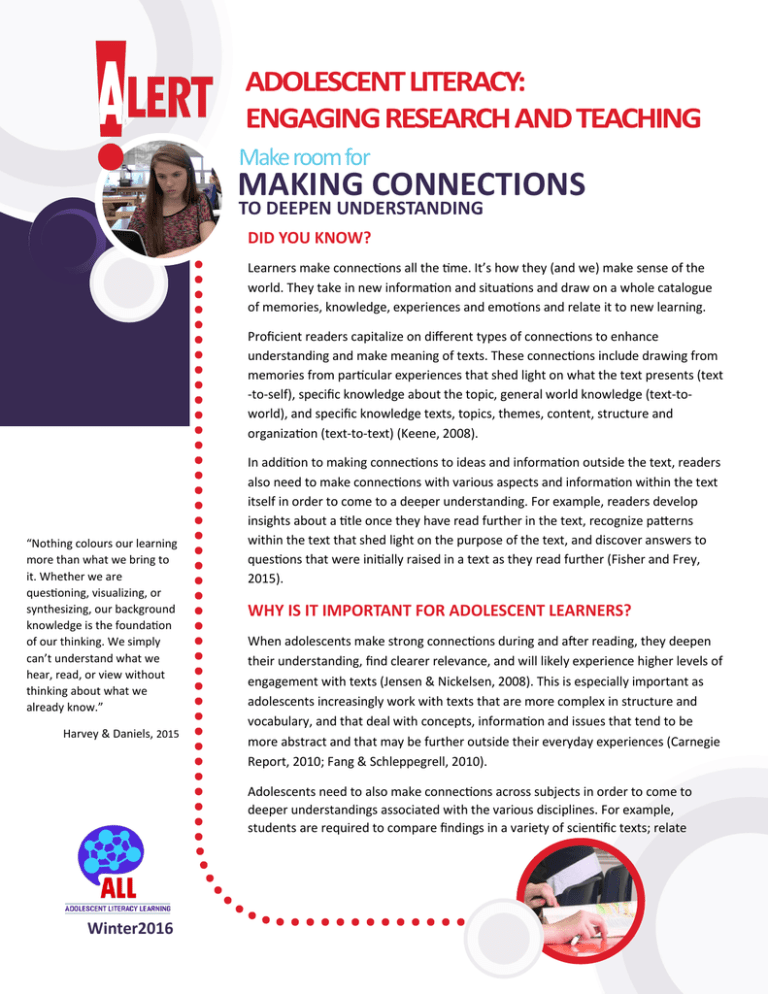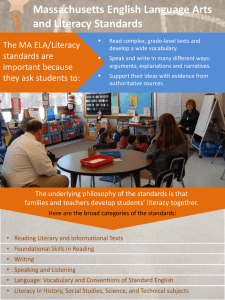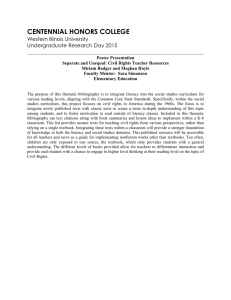Making Connections to Deepen Understanding
advertisement

Make room for MAKING CONNECTIONS TO DEEPEN UNDERSTANDING DID YOU KNOW? Learners make connections all the time. It’s how they (and we) make sense of the world. They take in new information and situations and draw on a whole catalogue of memories, knowledge, experiences and emotions and relate it to new learning. Proficient readers capitalize on different types of connections to enhance understanding and make meaning of texts. These connections include drawing from memories from particular experiences that shed light on what the text presents (text -to-self), specific knowledge about the topic, general world knowledge (text-toworld), and specific knowledge texts, topics, themes, content, structure and organization (text-to-text) (Keene, 2008). “Nothing colours our learning more than what we bring to it. Whether we are questioning, visualizing, or synthesizing, our background knowledge is the foundation of our thinking. We simply can’t understand what we hear, read, or view without thinking about what we already know.” Harvey & Daniels, 2015 In addition to making connections to ideas and information outside the text, readers also need to make connections with various aspects and information within the text itself in order to come to a deeper understanding. For example, readers develop insights about a title once they have read further in the text, recognize patterns within the text that shed light on the purpose of the text, and discover answers to questions that were initially raised in a text as they read further (Fisher and Frey, 2015). WHY IS IT IMPORTANT FOR ADOLESCENT LEARNERS? When adolescents make strong connections during and after reading, they deepen their understanding, find clearer relevance, and will likely experience higher levels of engagement with texts (Jensen & Nickelsen, 2008). This is especially important as adolescents increasingly work with texts that are more complex in structure and vocabulary, and that deal with concepts, information and issues that tend to be more abstract and that may be further outside their everyday experiences (Carnegie Report, 2010; Fang & Schleppegrell, 2010). Adolescents need to also make connections across subjects in order to come to deeper understandings associated with the various disciplines. For example, students are required to compare findings in a variety of scientific texts; relate Winter2016 empathetically to characters in literature; evaluate the appropriateness of media versions of historical events; understand the problems and contexts that lead to discoveries in technology; consider perspectives related to political and social conflicts; and determine the potential implications of data related to social phenomena (Keene, 2008; Fisher & Frey, 2015). IN THE CLASSROOM GETTING STARTED Establish safe classroom environments that support students in making relevant connections. Model making connections with a variety of types of texts, including visual and auditory texts. Use media texts to show how some of the same kinds of connections that deepen understanding of the media text also work for reading. Use think alouds to explicitly demonstrate the different connections that readers may make with a text. Be explicit about how the connections deepen the understanding of what is being read. Allow for exploratory talk in partners and small groups, including opportunities for English language learners to use their first language, so that students can share connections to texts that they make, and to hear the connections others make. Point out that the connections we make are informed by a number of factors, including prior knowledge and experiences as well as the perspectives and attitudes related to the topic or issue. Use assessment for learning tools early in a unit of study to assess student prior knowledge and experience related to a topic or types of texts they will use. Use the assessment information to identify any misconceptions and target appropriate entry points for instruction. TRY IT OUT: DOUBLE ENTRY JOURNALS Double entry journals provide a structure for students to document significant phrases and passages from a text (or parts of an image for a visual text) in the left column. Then for Sample Double Entry Journal Sample Text The Difference between Good and Great From the text Is it practice or natural talent? Canadian writer Malcolm Gladwell says there is no such thing as ‘natural talent.’ He says it is all about practice. Gladwell uses the Beatles Gladwell popularized the idea of the “10,000-hour rule.” Gladwell looked at how famous musicians (The Beatles), business people (Bill Gates) and athletes (NHL players) became experts at what they do. He found that they all spent a great deal of time practicing. Practice, not natural ability, made them great. as an example of It wasn’t just any practice. It was deliberate and focused practice. For those people who we consider great, Gladwell said that it takes about 10,000 hours of practice for them to reach such high level of success, whereas it takes a person about 4000 hours of practice to be good. This means, for example, a 10 year-old who wants to be one of the best guitar players by the time he or she is 20, would need to practice 1000 hours a year, or over 19 hours in a week (every week), or almost... 2 musicians who are great Connections The school band did some Beatles songs at last year’s musical revue “It wasn’t just any Going to football practice practice. It was everyday, and being deliberate and focused focused, for the whole practice.” season is going to make me that much better than the person with just talent each part taken from the text, the reader describes the connection they’ve made to that part of the text, in the column on the right. DELVING DEEPER WITH CONNECTIONS The more connections students can make to a text they are reading or viewing, the more likely they are to understand it (Weaver, 2002). However, not all connections will lead students to deep understanding and engagement in the text. In fact, sometimes the ‘connections’ that students make can be more distracting, and actually take students away from the text, rather than taking the reader more deeply into the ideas related to the text. So, it is important for students to monitor, on a metacognitive level, the degree to which the connection they are making is actually deepening their understanding. One way to help students be aware of the connections they are making, and the degree to which these connections help them to enhance their understanding is to have them track and analyse the connections they are making. The purpose of this instructional strategy is to help students recognize that all the connections are not equally valuable for deepening their understanding of the text. From the text Connections Insight or Dead End? Gladwell uses the Beatles The school band did some Dead end as an example of How the Connection Adds to My Understanding Beatles songs at last musicians that are great year’s musical revue “It wasn’t just any Going to football practice practice. It was everyday, and being deliberate and focused focused, for the whole practice.” season is going to make But, my time that I Insight practice is no where close to the 1000 hours a year (and I didn’t start at age 10), even though I think I me that much better than practice a lot. This gives the person with just me an idea about how much talent practice Gladwell is talking about. I guess that’s what it means in the title, the difference between good and great. This graphic organizer extends the double entry journal. As with the double entry journal, a reader notes significant phrases and passages from the text in the first column, and the connections that are made with that part of the text in the second column. In the third column, readers determine whether the connection is an “Insight” or a “Dead End”. In the fourth column, the student notes how the connection has added to his or her understanding of what was read (Barnhouse & Vinton, 2012). 3 The Adolescent Literacy Guide outlines components which support students’ abilities to think, express and reflect. Strategy is one of the components to which this ALERT connects. HYPERLINKING One way to prompt students to make connections is by using prompts which elicit text-to-self, text-to-text, and text-to-world connections. If students are working with electronic versions of the text, they can show their connections by hyperlinking phrases and passages from the text to online content including images and songs (e.g., representing text-to-self connections, such as memories and experiences), excerpts from research articles and videos of procedures or performances (e.g., representing text-to-text connections) and news stories and locations on maps (e.g., representing text-to-world connections). Once students have created their hyperlinked text, conference with students and ask them to explain the types of connections they used in their hyperlinks and describe how these connections helped them understand the text. If students are using these notes further, for example, for a writing task, help students to distinguish which types of information will be appropriate for the purpose and learning goals of the task. IN BRIEF It is not enough for adolescent readers to name things they are reminded of when they are reading. Making connections is about drawing on knowledge, both outside and inside the text, to come to a deeper understanding of the ideas and information in a text. FOR MORE ON... Adolescent Literacy Literacy GAINS. (2012) Adolescent Literacy Guide: A Professional Learning Resource for Literacy, Grades 7-12 REFERENCES Background Knowledge Barnhouse, D. & Vinton, V. (2012). What Readers Really Do: Teaching the Process of Meaning Making. Portsmouth, NH: Heinemann. Carnegie Council on Advancing Adolescent Literacy. (2010). Time to Act: An Agenda for Advancing Adolescent Literacy. New York: Carnegie Corporation of New York. Fang, Z. & Schleppegrell, M. J. (April 2010). “Disciplinary literacies across content areas: Supporting secondary reading through functional language analysis”, Journal of Adolescent and Adult Literacy, International Reading Association, 53 (7), 587-597. Harvey, S. & Daniels, H. (2015). Comprehension and Collaboration: Inquiry Circles for Curiosity, Engagement and Understanding. Portsmouth, NH: Heinemann. Fisher, D. & Frey, N. (2015). Text-Dependent Questions: Pathways to Close and Critical Reading. Thousand Oaks, CA: Corwin. Jensen, E. & Nickelsen, L. (2008). Deeper Learning: Seven Powerful Strategies for In-Depth & Longer-Lasting Learning. Thousand Oaks, CA: Corwin Press. Keene, E. (2008). To Understand: New Horizons in Reading Comprehension. Portsmouth, NH: Heinemann. Weaver, C. (2002). Reading Process and Practice, 3rd edition. Portsmouth, NH: Heinemann. Literacy GAINS (Spring 2013). ALERT: Make room for Building Background Knowledge 4 Inference Literacy GAINS (Winter 2015) ALERT: Make room for Inferring During Reading



